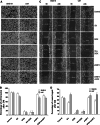Doxorubicin-mediated apoptosis in glioma cells requires NFAT3
- PMID: 19784808
- PMCID: PMC2809824
- DOI: 10.1007/s00018-009-0157-5
Doxorubicin-mediated apoptosis in glioma cells requires NFAT3
Abstract
Nuclear factor of activated T cells (NFAT), a family of transcription factors, has been implicated in many cellular processes, including some cancers. Here, we characterize, for the first time, the role of NFAT3 in doxorubicin (DOX)-mediated apoptosis, migration, and invasion in SNB19 and U87 glioma cells. This study demonstrates that the specific knockdown of NFAT3 results in a dramatic inhibition of the apoptotic effect induced by DOX and favors cell survival. Inhibition of NFAT3 activation by shNFAT3 (shNF3) significantly downregulated tumor necrosis factor (TNF)-alpha induction, its receptor TNFR1, caspase 10, caspase 3, and poly (ADP-ribose) polymerase, abrogating DOX-mediated apoptosis in glioma cells. DOX treatment resulted in NFAT3 translocation to the nucleus. Similarly, shNF3 treatment in SNB19 and U87 cells reversed DOX-induced inhibition of cell migration and invasion, as determined by wound healing and matrigel invasion assays. Taken together, these results indicate that NFAT3 is a prerequisite for the induction of DOX-mediated apoptosis in glioma cells.
Figures





Similar articles
-
Activation of a nuclear factor of activated T-lymphocyte-3 (NFAT3) by oxidative stress in carboplatin-mediated renal apoptosis.Br J Pharmacol. 2010 Dec;161(7):1661-76. doi: 10.1111/j.1476-5381.2010.00989.x. Br J Pharmacol. 2010. PMID: 20718735 Free PMC article.
-
p85alpha acts as a novel signal transducer for mediation of cellular apoptotic response to UV radiation.Mol Cell Biol. 2007 Apr;27(7):2713-31. doi: 10.1128/MCB.00657-06. Epub 2007 Jan 22. Mol Cell Biol. 2007. PMID: 17242187 Free PMC article.
-
Direct evidence for the critical role of NFAT3 in benzo[a]pyrene diol-epoxide-induced cell transformation through mediation of inflammatory cytokine TNF induction in mouse epidermal Cl41 cells.Carcinogenesis. 2007 Oct;28(10):2218-26. doi: 10.1093/carcin/bgm115. Epub 2007 May 23. Carcinogenesis. 2007. PMID: 17522069
-
A combined treatment TNF-alpha/doxorubicin alleviates the resistance of MCF-7/Adr cells to cytotoxic treatment.Biochim Biophys Acta. 2006 Feb;1763(2):182-7. doi: 10.1016/j.bbamcr.2005.12.008. Epub 2006 Jan 6. Biochim Biophys Acta. 2006. PMID: 16483679
-
The transcription factor NFAT3 mediates neuronal survival.J Biol Chem. 2005 Jan 28;280(4):2818-25. doi: 10.1074/jbc.M408741200. Epub 2004 Nov 10. J Biol Chem. 2005. PMID: 15537643
Cited by
-
Role of methamphetamine on glioblastoma cytotoxicity induced by doxorubicin and methotrexate.Neurotox Res. 2014 Oct;26(3):216-27. doi: 10.1007/s12640-014-9464-1. Epub 2014 Mar 21. Neurotox Res. 2014. PMID: 24652521
-
Specific Compositions of Cannabis sativa Compounds Have Cytotoxic Activity and Inhibit Motility and Colony Formation of Human Glioblastoma Cells In Vitro.Cancers (Basel). 2021 Apr 5;13(7):1720. doi: 10.3390/cancers13071720. Cancers (Basel). 2021. PMID: 33916466 Free PMC article.
-
Recent knowledge of NFATc4 in oncogenesis and cancer prognosis.Cancer Cell Int. 2022 Jun 13;22(1):212. doi: 10.1186/s12935-022-02619-6. Cancer Cell Int. 2022. PMID: 35698138 Free PMC article. Review.
-
PMA and ionomycin induce glioblastoma cell death: activation-induced cell-death-like phenomena occur in glioma cells.PLoS One. 2013 Oct 9;8(10):e76717. doi: 10.1371/journal.pone.0076717. eCollection 2013. PLoS One. 2013. PMID: 24130787 Free PMC article.
-
Downregulation of uPAR and cathepsin B induces apoptosis via regulation of Bcl-2 and Bax and inhibition of the PI3K/Akt pathway in gliomas.PLoS One. 2010 Oct 29;5(10):e13731. doi: 10.1371/journal.pone.0013731. PLoS One. 2010. Retraction in: PLoS One. 2020 Jan 29;15(1):e0228688. doi: 10.1371/journal.pone.0228688. PMID: 21060833 Free PMC article. Retracted.
References
Publication types
MeSH terms
Substances
Grants and funding
LinkOut - more resources
Full Text Sources
Research Materials
Miscellaneous

